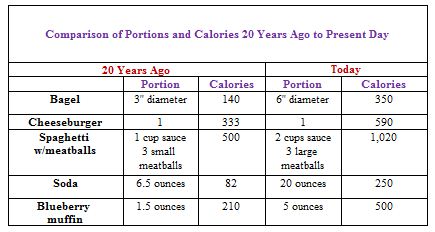
Serving Size And Portion: What is the Confusion ?
Healthy eating includes making decision on what to eat and how much eat. There is a difference between serving size of a food and portion of food that we consume. Many times it is hard to say what is the right serving size or portion of food on our day-to-day nutritional needs.
National Institutes of Health defines portion and serving size as below:
Portion is how much food you choose to eat at one time, whether in a restaurant, from a package or in your own kitchen. A portion is 100 percent under our control. A “portion” is the amount of a food you choose to eat at any one time — which may be more or less than a serving.
Serving Size is the amount of food listed on a product’s Nutrition Facts label. So all of the nutritional values you see on the label are for the serving size the manufacturer suggests on the package.
A portion is the amount of food that you choose to eat for a meal or snack. It can be big or small, you decide.
A serving is a measured amount of food or drink, such as one slice of bread or one cup (eight ounces) of milk.
How can we eat and serve smaller portions?
Try these healthy tips to control portion sizes at home:
- When cooking at home: Offer the proper “serving” to each member of the family, then put the extra food away. Save leftovers for another meal.
- Shrink the plates: Having a smaller plate may make it look as though there’s more food on it. It’s a way to “trick” your brain into thinking you are getting more.
- You will tend to eat more if you eat directly out of a container or box. Put a handful of crackers on a plate instead of reaching into the box, and put ice cream in a bowl instead of eating it out of the carton.
- Watching movies at home or at the theatre: Don’t eat while watching TV or a movie or when you’re on the computer. It’s harder to control how much you’re eating if you don’t pay attention to what you’re putting in your mouth, and when. At the movies, share a box of popcorn, and avoid the free-refill tubs and skip the candy.
- Drink water before eating: If you drink a big glass of water before you sit down to eat, you’ll feel fuller and won’t be tempted to eat as much.
- Wait more than a second for seconds: Eat a moderate first serving of food. Then, wait a few minutes before going back for seconds. It takes 20 minutes for your stomach to tell your brain that it is full, so after waiting you might find that you are no longer hungry enough for that second helping.
- Keep it simple: Prepare foods that have easy-to-see portions. You can also buy foods in individual portions (make sure you check on the label) to take out some of the guesswork.
- At snack time: Never eat straight from the bag or box. Measure out snacks, including fruits and veggies, into appropriate portion sizes before giving them to your kids.
Do you know how the portion and calorie intake has evolved in past 2 decades? The portion that one person eat today can satisfy calorie intake of 2 to 3 people today and this change is called portion distortion.
A serving size on food label helps us identify how many calories and nutrients are in a food.
Here are some everyday comparisons to help you figure out your serving sizes.
- 1 teaspoon of margarine is the size of one dice
- 3 ounces of meat is the size of a deck of cards
- 1 cup of pasta is the size of a baseball
- 1½ ounces of cheese is the size of four stacked dice
- ½ cup of fresh fruit is the size of a tennis ball
When a label refers to “one serving,” it really means:
- 1 slice of bread (so a sandwich has two servings of bread)
- ½ cup cooked rice or pasta
- 1 pancake (about the size of a CD)
- 1 small piece of fruit (about the size of your fist)
- ½ cup fruit juice (most small bottles of juice have more than this so make sure to read the label)
- 1 cup of milk or yogurt
- 1 teaspoon of margarine (about the size of half your thumb)
- ½ cup of ice cream (about the size of a baseball)
- 2 ounces cheese (about the size of a small matchbox)
- 2 to 3 ounces meat, chicken or fish (about the size of a deck of cards)
Some common foods portion and serving size guide as per Food guide pyramid.
References: http://www.afitnessminuteblog.com/
http://www.heart.org/
http://mollenfoundation.org/
https://www.eatrightontario.ca
Image courtesy: https://www.nhlbi.nih.gov/
Author: Sumana Rao | Posted on: September 9, 2019
« Tips to prevent heart attack in women Your sleep depends on your blanket too »
























Write a comment